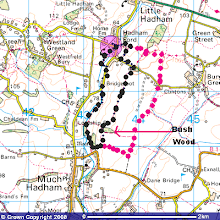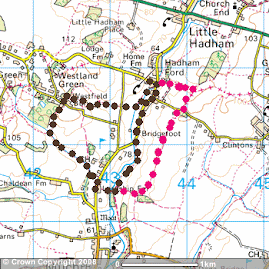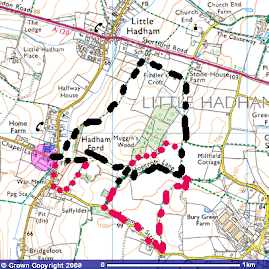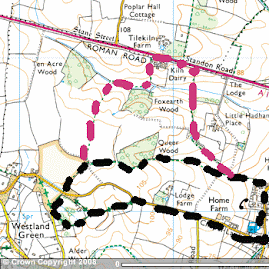Today's habitats are all a little further afield and may require either a long walk or a drive.
Stansted Airport Lagoons:
Take the old road to Takeley from the M11 roundabout. After entering Takeley Street there is a layby on the right in front of a row of bungalows just before the turning to Hatfield Forest and the Green Man pub. Park here and walk past the pub until you reach the last building, Primo, a tile company. Right next to this is a footpath which takes you into a field. After 100 yards a footbridge over the stream into a small copse. The path forks, take the left hand one that emerges by a water treatment installation, up the slope and the 3 lagoons are in front of you. A tarmac track to the right, or a grass wander to the left. Signs state no walking along the path through the middle. I have wandered along here and normally no problem but occasionally a chap in a yellow airport Range Rover appears to tell you to go back. If there are plenty of Canada geese present he may be there already as he warns the flight controllers if the geese are flying off towards the runway. Worth asking for permission to use the centre track. However, with binoculars, all three lagoons can be viewed from the permissive areas.
Mainly a waterfowl site with Mallard, Coot, Little Grebe, Teal, occasional Wigeon and Shoveller, Gadwall pairs, Tufted duck and Mute swan. However, always worth checking the water's edge for small waders, particularly Snipe and Green sandpiper. Over the years, many good waders have been found here, only last year I encountered a Wood sandpiper during September migration. This is the best time for the lagoons but once winter has established itself, many other species are possibilities.
By the water treatment works there is often a Grey wagtail. This usually feeds on the muddy bank near the sluice at the end of the lagoon on the left. Approach quietly for good views. Gull species can also be present along with noisy Canada geese and Greylags. Magpies and Jays frequent the trees that encircle the site where there are also Goldfinches, Chaffinches, Reed buntings, Linnets and always a chance of an over wintering Chiffchaff or Blackcap.
Two years ago a Greenshank overwintered on the back right hand side lagoon. Little egrets are regular visitors, as are Grey herons. If we get a really cold snap always worth checking the water as it can remain ice free. To keep the water well oxygenated there are pumps installed, rather like a huge jacuzzi. These come on at regular intervals and tend to stop the water icing over. Always possible that wildfowl from other sites that have iced over will drop in here such as Pochard, usually the well plumaged male. Female Pochard tend to migrate further south to The Camargue and the Iberian peninsula, males don't seem to go so far. The thinking behind this is that the males can return to the breeding grounds earlier and establish a territory before the arrivals of the female from their Winter sun holiday.
Pied wagtails and Meadow pipits can be watched on the stretches of mud at the far end of the two larger lagoons. Always worth a good scan across these areas as there maybe small waders present, too.
A good site and one that can be covered fairly quickly. Early mornings are best but there will be birds present throughout the day.
 |
| Teal |
Aubrey Buxton Essex Wildlife Reserve:
Accessed north of Stansted. At the roundabout for the new building site north of the village there is a turning on to a lane on the right. Alsa Lane, if I recall correctly. Drive up here for a few hundred yards until there is a track in front of you and a sharp left hand bend. Take the bumpy track, a permissible one and there is a small carpark for 4- 6 cars at the entrance to the reserve.
Typical woodland birds will be present throughout winter: Great spotted woodpecker, Wren, finch flocks including linnets and, I suspect Redpolls and Siskins. There are a series of small ponds on which Moorhens and Mallards can be found but worth checking for anything else that might have dropped in. Numerous Jackdaws, Magpies and Jays and often a flock of House Sparrows by the hut near the largest pond.
The path goes all the way around and at the far end there is a small exit on to a fallow field. Check the hedge here for Yellowhammers and tit flocks. Back in the reserve there are plenty of Great, Blue and Long Tailed tit and, occasionally a Marsh tit. Listen out for its distinctive "PerChoo Perchoo" call. Also, Coal tits and Goldcrests frequent the conifers whilst Nutchatches and Tree creepers can be found with a little patience.
This wonderful site can easily be covered in an hour. A wealth of tree species as well as a few areas of grassland give the reserve good diversity of species. Sure there will be Little Owls and Tawny owls present, but I have yet to see them. Have heard tawny whilst running a moth trap there one evening. Pied and Grey wagtails by the lower pond, often found wandering along the tree trunk that lies across the water. Well worth a visit.
 |
| Marsh tit, black cap with no white on it as in Coal tit |
 |
| Coal tit, note white on the nape. |
Hatfield Forest and Flitch Way:
A very well known site. To make this into a longer walk park under the old railway bridge on the lane to Hallingbury that is directly opposite the petrol station on the old road to Takeley. Once parked take the path on to the old railway line and turn right. Plenty of bird life in the dense vegetation all the way along the track until you reach a gate and the entrance to the forest. Tits and finches will be regular sightings and possibly Nuthatch and overwintering warblers such as Blackcap or Chiffchaff. Check some of the larger ivy clad trees for Tawny owls that use the ivy to hide during their day roost. A good sign that one is present is to hear and then observe small birds such as Tits and Blackbirds alarm calling around a tree. Often an indication of an owl being present although the small birds will do this if a Sparrowhawk, Common buzzard or even Red kite are present.
Once into the forest there are plenty of opportunities to spot regular birds but the best area will be the lake with wildfowl such as Greylag geese, Canada geese, Great crested grebe, Little grebes, Mallards, Coots, Pochard and always a chance of other duck species cropping up. Little egrets occasionally along with gull species, mainly Black headed but always worth checking for a less common species.
Near the car park, usually to the left there can be several overwintering hawfinches. These rare Hertfordshire visitors will certainly be flagged up on Stortford Nature FB if they appear, as will another couple of winter visitors that use the forest: Brambling and Waxwing.
Another good site for Hawfinch in Herts is Bramfield churchyard, just outside Hertford. Shall put out an alert if these turn up here.
 |
| Brambling, often associates with chaffinch flocks |
There are plenty of other woodland sites around the town but searching deciduous woodland for birds can be hard work and frequently unrewarding, so I have left out many of our local woods. However, always worth a check.












































No comments:
Post a Comment